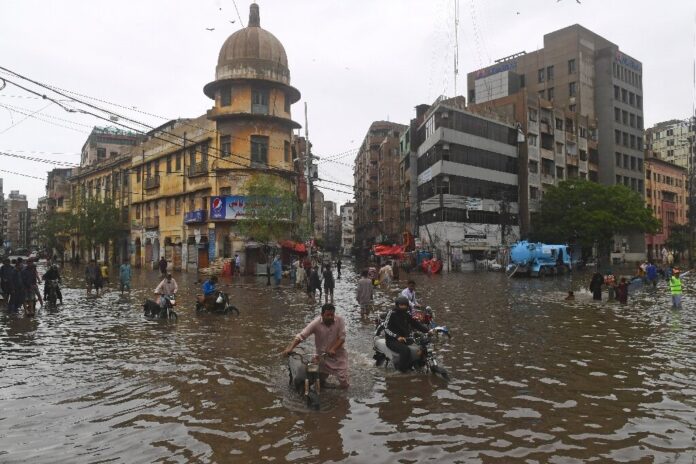Within a climate there are patterns and there are anomalies: the sun ascending in the morning and descending in the afternoon is a pattern; meanwhile, earthquakes, landslides, and lightning strikes are all anomalies. Monsoon rainfall is not an anomaly; monthly data on rates of precipitation and the geographical distribution of that precipitation for the past several years along with newspaper reports, journalist photography, and civilian accounts all testify to this fact. Yet, each year conversations on monsoon rainfall are dealt with as exactly that, an anomaly, attracting words like, ‘unfortunate’, ‘chaos’, and ‘disaster’, all falsities, until the situation just about does become an unfortunate, chaotic disaster.
Perhaps the greatest pattern of all, and certainly one of the most significant in recent times, is the coronavirus, where patterns could be formed from person to person, city to city, and across borders. International attention helped, but most importantly it was the indiscriminate spread of covid-19 that dismantled the nonsensical back-and-forth of manipulators. Life and death know no interests and we must recognize the same with the detrimenta effects of Pakistan’s monsoon rain. Ignorance is a hindrance to practical progress. Patterns can be downplayed, manipulated, and ignored, but they cannot be falsified
Granted, there may be anomalies within existing patterns of monsoon a factor increasingly common, fueled and exacerbated by climate change – however, being equipped with weather information spanning over several decades allows us to accurately predict and best prepare for the challenges to come, well in advance. It is worth noting that these anomalies may appear in diametrically opposite directions: 2018 had the driest monsoon in two decades, whereas the first spell of monsoon 2022 has brought one of the highest average rain per mm to date in Karachi, according to Pakistan Meteorological Department (PMD) reports.
Comprehensive
figures and estimations on rainfall patterns are indispensable information in
relief planning by government authorities, but at the same time, notices and
warnings of floods are equally important for the common person’s precautions against inclement weather– including, but not limited to, adjusting office hours, avoiding underpasses and steering clear of power lines and live electric wires. Unfortunately, a large proportion of the general public, despite their own interest, never get such news, instead only observing the immediate outcomes of heavy monsoon rain – a sight of death, disaster, and desperation, further reinforcing the anomaly mindset.
Meteorologists today, armed with modern technology and superior prediction systems, have
found ways to introduce an additional line of defense against natural disasters such as volcanic eruptions, hurricanes, and tsunamis, all once considered gargantuan disasters and complete anomalies. Additionally, through the use of sophisticated alert protocols consisting of warning sirens, SMS alerts, and multi-channel news delivery, government authorities manage to buy civilians likely to be affected, some crucial time to seek shelter. Evidently, the two operations of information production and circulation go hand-in-hand in delivering pre-emptive precautions, therefore, all concerned institutions must work together efficiently to produce practical results.
Official institutions, however, such as the PMD have been able to act as neither efficient nor effective tools of public announcement, instead handing the role to the next most obvious pick: political leaders. In Pakistan, it’s true that what political individuals have to say often has a greater impact than institutional statements, and where the interest of these individuals interferes with the truth, problems arise. When individuals holding public office accept the troubles of monsoon as a problem capable of solution, they also accept its burden.
Unfortunately, the debate on monsoon and flooding only gains momentum for a few weeks a
year and it is in the interest of politicians to reserve little attention for brief activism and instead prepare to deal with questions rather than problems. It is an essential element of democracy that people are made aware of the thinking behind policies because stakeholders can only contribute to solving a problem when they are meaningfully engaged in the process. By the same token, in a society where politicians deliver scientific news, excuses of using simplicity in wording for better communication will not suffice; “monsoon rain is a pattern and not an anomaly” is as simple a message as “jab ziyada baarish aata hai to ziyada paani aata hai” ( when it rains more,there’s more water).
Postmodernism states that online media and the emergence of social network journalism have made it easier than ever before for people to explore different perspectives on a matter– carrying real capacity to challenge the status quo. However, we cannot expect a substantial number of individuals to make conscious efforts to probe and question statements from individuals they likely already place their trust on.
Truthfully, politicians can not be expected nor be trusted with this responsibility; politicians should speak politics and scientists should speak science, because although politics almost certainly will bear opposition, science eventually comes to a consensus. We can only deal with patterns through agreement and the only way forward is inclusiveness and engagement of stakeholders.
Perhaps the greatest pattern of all, and certainly one of the most significant in recent times, is the coronavirus, where patterns could be formed from person to person, city to city, and across borders. International attention helped, but most importantly it was the indiscriminate spread of covid-19 that dismantled the nonsensical back-and-forth of manipulators. Life and death know no interests and we must recognize the same with the detrimenta effects of Pakistan’s monsoon rain. Ignorance is a hindrance to practical progress. Patterns can be downplayed, manipulated, and ignored, but they cannot be falsified.























